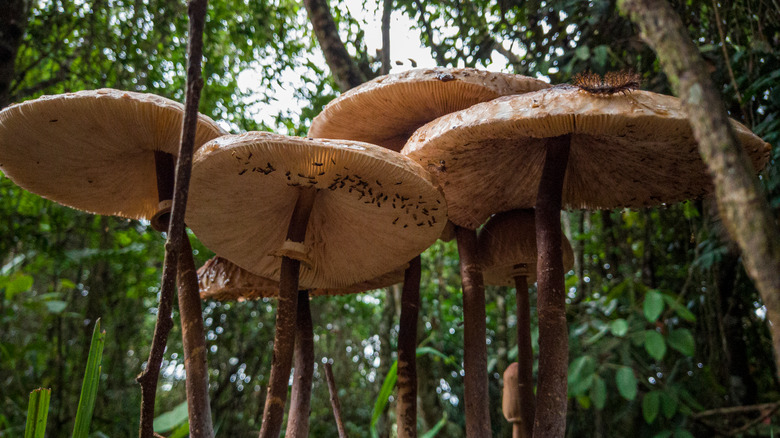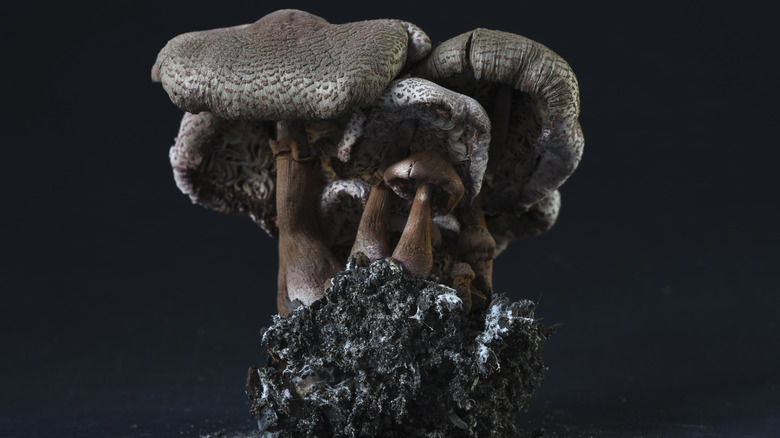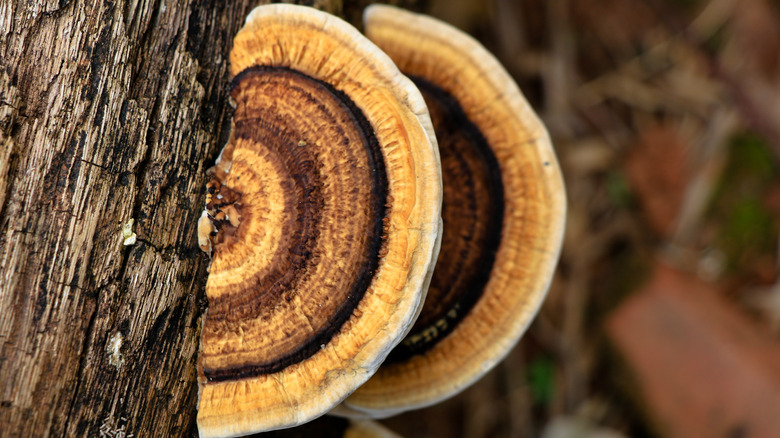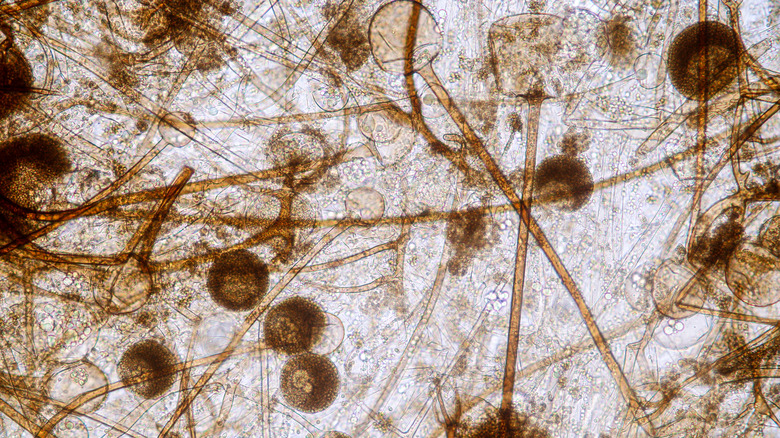Over 400 Million Years Ago, Giant Mushrooms Covered The Earth
The Earth formed about 4.6 billion years ago, with complex life on the planet only beginning to form in the last 500 million years. That represents just 12% of Earth's history, according to Dynamic Earth. Some 400 million years ago, stems had begun to form on the Earth's surface, with roots and leaves evolving (via Earth Archives). There were wingless insects, millipedes, and worms, but mammals and animals with spines did not yet exist (via Live Science).
Although we've learned a lot about the formation of the Earth and what many of the dinosaurs and pre-human organisms looked like based on archeological evidence, much remains a mystery. One such mystery, an organism with an unusually massive size and oddly familiar, mushroom-like shape, stumped researchers for more than a century (via Live Science). It was only through an archaeological experiment in Saudi Arabia that scientists finally uncovered the answers in 2007.
The 'mystery life-form'
This fossil was originally discovered by W.E. Logan in 1843, but it was not studied until the fossil was passed on to another scientist named J.W. Dawson in 1855, according to the Review of Palaeobotany and Palynology. Dawson was immediately drawn to this specimen, which stood at 24 feet tall and measured three feet wide — about three times the size of a Christmas Tree (per Earth Archives). Initially, Dawson named the organism the Prototaxites, which means, "early yew," and thought because of its shape it was a conifer tree (via Review of Paleobotany and Palynology).
However, another scientist came along in 1872 who was adamant that the specimen was a type of algae and classified it as Nematophyton. Later, Dawson "remained adamant in his definition of Prototaxites until he illegitimately substituted the name Nematophyton for Prototaxites and denied that he had ever classed the genus with the conifers," (via Review of Paleobotany and Palynology). Regardless, the initial naming stuck, even though scientists went on in 1919 to believe the specimen was a fungus and not algae or conifer (via Signs of the Times).
A chemical test
Researchers continued to hypothesize various identifications of the massive organism, which popped up among archaeological specimens all across the world, for decades. In the 1970s, Francis Hueber began studying the isotopes, or the chemical composition, of the fossil (per Signs of the Times). Isotopes vary depending on whether the organism eats other living matter. For example, plants that "eat" energy from the sun and carbon typically have two carbon isotopes balanced in their chemical signature (via Signs of the Times). But in humans, mammals, fungus, and other organisms that eat other living things, this ratio is unbalanced.
What Hueber and his team found in their 2001 study of this mysterious Prototaxites organism was that the fossil resembled that of a fungus, which eats decayed matter (via Earth Archives). They also found evidence that the organism was getting energy from underground organisms in the soil, further supporting the idea that it was a fungus, which gets energy from an underground network of roots and also uses this internet of fungus to communicate (via Earth Archives).
Not everyone is convinced
When Hueber published his work indicating the mysterious organism was a fungus, not everyone was convinced that he had found the solution so many scientists had worked decades to uncover. For one, it didn't make sense that such a giant fungus would be able to get enough nutrients and energy from decaying matter to survive. According to Signs of the Times, the other plants that existed at this time some 400 million years ago were "at most 6.5-feet tall, close to a quarter the size of one of these "mushrooms."
In an interview with Live Science, University of Chicago paleobotanist C. Kevin Boyce said any explanation for the living organism — albeit classified as a plant, fungus, or something else — might seem like a stretch in modern times, where we don't have any organisms that even faintly resemble this mysterious shrooming behemoth. "A 20-foot-tall fungus doesn't make any sense," he told Live Science. "Neither does a 20-foot-tall algae make any sense, but here's the fossil."
Looking within
In addition to studying the chemical composition of the mysterious organisms, Hueber journeyed to Canada, Australia, and Saudi Arabia to slice apart various fossils from around the world and see what the fungus (or plant, or something else?) looked like on the inside (via Live Science). What he found was that the inside of the Prototaxites consisted of "interwoven tubes just five to 50 microns across (50 microns is about half the width of a human hair)," according to Live Science.
Although algae and lichens can also have this structure, the internal workings of the fossil strongly indicated that it was a fungus. Still, according to what a paleontologist at the National Museum of Natural History who worked with Hueber, Carol Hotton, told Live Science, Hueber "agonized over the fact that he was never able to find a smoking gun in the form of reproductive structures that would convince the world that it was indeed a fungus." But taken together with the isotope research, he "built up a convincing case."
Why were they so big?
Now that it was determined what these organisms were, the next logical question is why were these fungi so large? What purpose did they serve in the world, with small plants just beginning to spread some 400 million years ago?
Although the answer to that question is purely speculative, scientists have a couple of hypotheses. Hotton told Live Science that the Prototaxites' large size could have been an evolutionary tactic to spread its reproductive spores further. Some mushrooms make their own wind to shoot out spores from the fruiting body of the mushroom hat, which go on to become new organisms. It makes sense that from such great heights, the spores of the Prototaxites would be able to ensure the survival of the species. Per Live Science, it could also just be that these organisms were not destroyed by other plant-eating species or humans like many fungi today.





